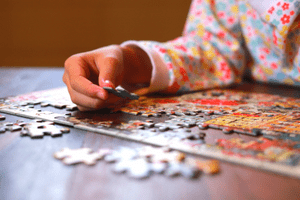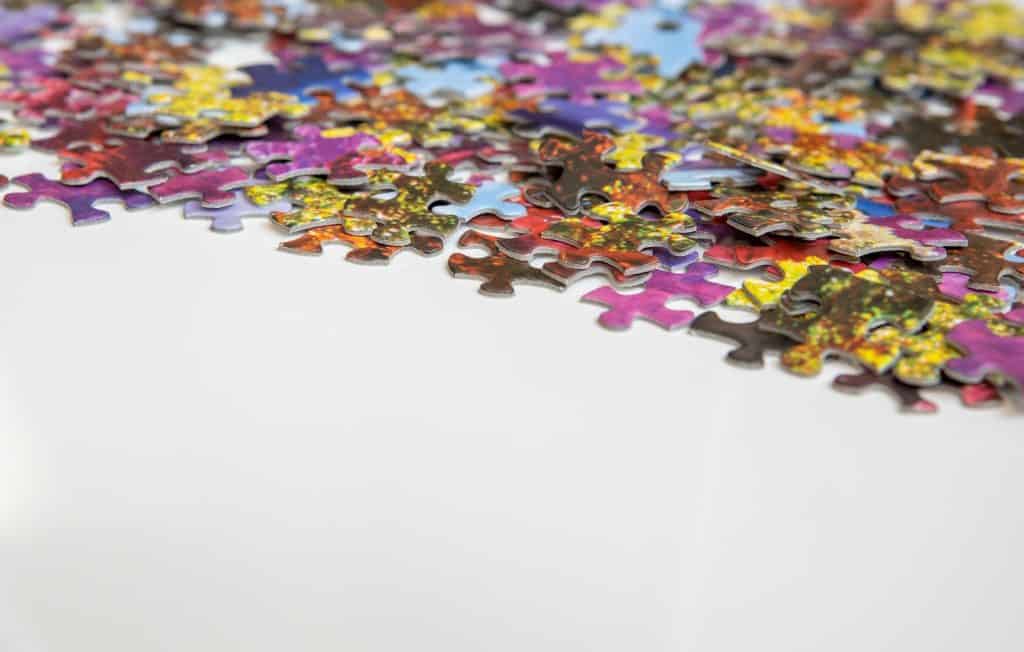Jigsaw puzzles have been around for centuries, and their popularity has only grown in recent years. But where did these curious contraptions come from? And how have they evolved over time?
Today, we’re taking a look at the history of jigsaw puzzles, from their humble beginnings to their modern-day iterations. So whether you’re a puzzle enthusiast or just curious about their origins, read on to learn more!
The history of jigsaw puzzles

Let’s take a look at the history of jigsaw puzzles.
Jigsaw puzzles were first invented in the late 1700s as a way to entertain children and adults alike
Jigsaw puzzles originated in the late 1700s as a popular pastime for both children and adults. Prior to this time, mapmakers utilized a form of wooden puzzles to create intricate and detailed designs. Since then, jigsaw puzzles have become one of the worldwide favorites when it comes to fun-filled indoor activities. They’re useful for relaxation, creating extraordinary works of art, inspiring creativity, teaching problem-solving techniques, and more. While the puzzle pieces have evolved over time with regard to shapes, sizes and materials used, we are still enjoying them almost just as much today as our ancestors did centuries ago!
The earliest jigsaw puzzles were made out of wood, and each piece was cut by hand
Jigsaw puzzles first made their appearance in the 1760s when European mapmaker John Spilsbury cut out each individual landmass from a map and mounted it on a piece of wood. Initially, these pieces were used as teaching tools for students to learn geography and history, however soon after the puzzles gained popularity amongst adults, and the craftsmanship behind creating them improved. More intricate patterns were designed, and some even depicted naïve figures or pastoral scenes. The first jigsaw puzzle to be mass-produced was created by a London mapmaker in 1766.
Jigsaw puzzles became more popular in the early 1900s, when companies began mass-producing them
In the early 1900s, jigsaw puzzles were introduced to the public, and it didn’t take long for the entertainment form to become massively popular. Companies soon caught on, and consequently began mass-producing them around this time, with factories popping up all over Europe and North America. With better production techniques and improved designs, these puzzles once seen as a mere amusement went from a niche hobby to an essential pastime, with people of various ages purchasing jigsaw puzzles in large quantities. This newfound accessibility made it easier than ever before to get lost in creating intricate works of art out of small pieces. Today, jigsaw puzzles are so beloved that they are almost ubiquitous in homes worldwide.
Today, there are many different types of jigsaw puzzles available, including those made out of plastic, cardboard, and even metal

Jigsaw puzzles have been a popular activity among adults and children all around the world for centuries. Initially invented in the 1700s by an English man named John Spilsbury, who used a saw to cut maps into pieces as a teaching aid, these particular creations were often made from wood and called Dissected Maps. It was not until 1883 when the first cardboard puzzles were offered for sale by an English publisher, featuring an engraving of verso design from ‘Curiosities of Knowledge’ printed on thick pasteboard. Today, we now enjoy the many varieties of jigsaw puzzles available–ranging from plastic to metal–offering a myriad of interactive experiences sure to thrill hobbyists and puzzlers alike!
Jigsaw puzzles are still a popular pastime for people of all ages, and they can be used as a form of therapy or relaxation
Jigsaw puzzles have a long and varied history, dating as far back as 1760 when European mapmakers began cutting up maps for an easier way to study geography. In the late 1800s, a British man by the name of John Spilsbury is regarded as the first puzzle-maker to market jigsaw puzzles, creating them out of thin wooden boards and printing maps on them. As time went on, jigsaw puzzles increased in complexity, eventually using larger pieces with intricate designs that can take hours or days to fit together.
Despite advancements in technology and gaming devices, jigsaw puzzles remain a popular pastime today due to their therapeutic value and convenience; whether it be for relaxation or physical therapy exercises for people with disabilities, jigsaw puzzles are used in many creative ways around the world.
Different kinds of modern jigsaw puzzle designs
Modern jigsaw puzzles come in a variety of different shapes and sizes, ranging from simple two-dimensional designs to more complex three-dimensional models. Some designs feature abstract artwork while others feature photographs, paintings, and illustrations. Additionally, many jigsaw puzzles are made out of materials like cardboard, plastic, or metal depending on the needs of the user. Companies have also recently begun to offer digitalized jigsaw puzzles, which can be solved using a tablet or computer.
Puzzle makers and enthusiasts continue to innovate and create new designs that challenge the minds of puzzlers. Nowadays, jigsaw puzzles have become a staple of family game nights, offering a great way to spend quality time together and have fun.
Jigsaw puzzles have been captivating
FAQs

Q1: What materials can jigsaw puzzles be made from?
A1: Jigsaw puzzles can be made from a variety of materials including wood, plastic, cardboard, and metal.
Q2: What are the benefits of solving jigsaw puzzles?
A2: Solving jigsaw puzzles can provide many benefits, such as increased focus and concentration, improved problem-solving skills, and relaxation.
Q3: Who invented jigsaw puzzles?
A3: John Spilsbury is credited as the first puzzle- to market jigsaw puzzles, creating them out of thin wooden boards and printing maps on them in the late 1800s.
Q4: Are there digital jigsaw puzzles?
A4: Yes, some companies offer digital jigsaw puzzles which can be solved using a tablet or computer.
Q5: Why is it called jigsaw puzzles?
A5: The name “jigsaw” comes from the tool used to cut the pieces of a puzzle – a jigsaw. This tool allows for intricate and accurate shapes to be cut into the puzzle.
Q6: How long have jigsaw puzzles been around?
A6: Jigsaw puzzles date back to the late 1700s when European mapmakers began cutting up maps for an easier way to study geography.
Q7: What can jigsaw puzzles be used for?
A7: Jigsaw puzzles can be used for many different purposes, such as relaxation, physical therapy exercises for people with disabilities, and problem-solving skills. Additionally, they can also be used as creative decorations.
Q8: What are the different types of jigsaw puzzles?
A8: Jigsaw puzzles come in a variety of different shapes and sizes, ranging from simple two-dimensional designs to more complex three-dimensional models. Some designs feature abstract artwork while others feature photographs, paintings and illustrations. Additionally, many jigsaw puzzles are made out of materials like cardboard, plastic, or metal.
Final thoughts: The history of jigsaw puzzles
Jigsaw puzzle history is fascinating, as it reveals an ancient pastime that has stood the test of time. From its humble beginnings up until now, jigsaw puzzles continue to captivate the minds of people from all walks of life. Whether it is used for relaxation, physical therapy, or simply to have a fun game night, jigsaw puzzles remain a popular activity that can be enjoyed by all.
For more related articles:

